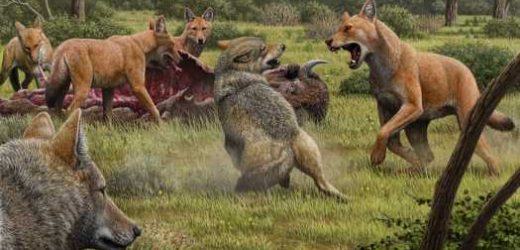The dire wolf, an animal many people know from its fictional incarnation in “Game of Thrones” was a heavy-boned, powerful predator that roamed North America up to about 11,000 years ago, or perhaps even later, preying on large animals like extinct horses, bison, sloths and even mammoths.
While it was nowhere near as big as its television version, the dire wolf was about 20 percent larger on average than the gray wolf, and it was long considered a sister species, Canis dirus rather than Canis lupus.
But an international team of scientists reported Wednesday in the journal Nature that the first sequencing of the dire wolf genome showed an unexpectedly large genetic separation between the two species, big enough that the dire wolf is not just a separate species but a separate genus. They resurrected an old name, Aenocyon, for the genus, first suggested in 1918 by John Merriam, a paleontologist, but soon discarded. The dire wolf is the sole species in the genus.
The last common ancestor of the gray wolf and the dire wolf was about 5.7 million years ago, the researchers reported. And another surprise was that the dire wolf didn’t seem to interbreed with other species — as dogs, wolves, coyotes and other canids do. In evolutionary terms, it met a lonely end.
Angela Perri, an archaeologist at Durham University in England, one of the leaders of the research, said of the new work, “a hundred years later we are saying that Merriam was right.”
What made the change possible was the effort made by the many scientific groups that participated in the project to find enough ancient DNA.
The problem was not a lack of old bones. The vast majority come from the La Brea Tar Pits in Los Angeles County, where the remains of about 4,000 animals have been recovered. Tar apparently plays havoc with recoverable DNA and until now, nobody had been able to sequence the dire wolf’s genome.
The researchers compared the dire wolf data with previously sequenced genomes of a number of other species, including wolves, foxes, jackals and dholes. The data showed how long ago the species split apart and how distant they are.
The long genetic isolation is significant in another way.
Larisa DeSantis, a paleontologist at Vanderbilt University, who was not involved in the research, said it “is consistent with the idea of a North American origin of dire wolves.”
They were here at least 250,000 years ago, and they were still around, although nearing the end of their existence, when the first humans were arriving in the Americas, perhaps 15,000 years ago.
“They were not this ginormous mythical creature, but an animal that most likely interacted with humans,” Dr. Perri said.
In the search for fossils that could provide ancient dire wolf DNA, Dr. Perri joined forces with a number of other researchers around the world, including Kieren Mitchell, an evolutionary biologist at the University of Adelaide; Alice Mouton, a geneticist at the University of Los Angeles; and Sandra Álvarez-Carretero, a genomics doctoral student at Queen Mary University of London.
They combed museums to find 46 bone samples that might have usable DNA. Five did. “We got really lucky,” Dr. Perri said. “And we found a lot of things we didn’t really expect.”
The findings were surprising because dire wolf skeletons are similar to gray wolf skeletons, and because DNA was not available. Xiaoming Wang, a paleontologist at the Los Angeles County Natural History Museum, who published a review of the fossil evidence in 2009 that placed the dire wolf squarely in the genus Canis, called the new paper a “milestone,” adding that “morphology is not foolproof.”
As to why the dire wolf went extinct and wolves survived, the authors speculated that its long genetic isolation and lack of interbreeding with other species may have made it less able to adapt to the disappearance of its main prey species. More promiscuous species like gray wolves and coyotes were acquiring potentially useful genes from other species.
Laurent Frantz, an ancient DNA specialist at the University of Oxford and one of the paper’s authors, said that finding was a reminder of the evolutionary success of gray wolves. Their wide variation in size and ability to adapt to different prey species helped them escape the fate of the dire wolf. Now, of course, they face many threats in Europe and the United States.
“It’s the ultimate carnivore survivor,” he said, “until it faces humans.”
Source: Read Full Article



